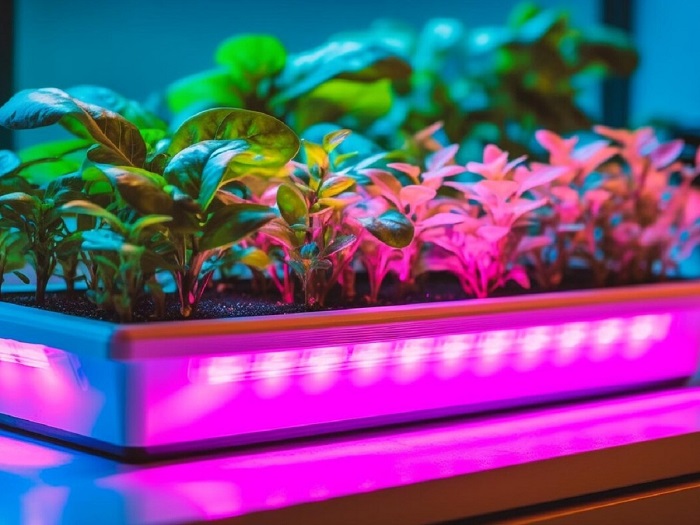Seedlings are a starchy stage for growing plants, on which the further success of the crop depends. One of the key aspects of growing healthy seedlings is proper illumination. Modern technologies in the field of agriculture offer us an innovative and effective tool — phytolamps . Let’s dive into the world of phytolamps for seedlings and learn their advantages and use.
Content:
1. Phytolamps: Basic principles of action
1.1 The influence of light on the growth of plants
1.2 The role of different light spectra in seedling development
2. Types of phytolamps for seedlings
2.1 LED lamps
2.2 Highly saturated mercury lamps
2.3 Other types and their advantages
3. Choosing the right spectrum
3.1 Spectral needs of seedlings at different stages of growth
3.2 Adaptation to the variable needs of plants
4. Efficiency and energy saving
4.1 Comparison with traditional light sources
4.2 Impact on electricity costs
5. Correct use of phytolamps for optimal growth
5.1 Recommendations for installation and placement
5.2 Lighting regimes at different stages of seedling growth
6. Ecological advantages and renewable resources
6.1 Impact on the environment
6.2 Recycling and secondary use
7. Conclusion
1. Phytolamps: Basic principles of action
Light plays an important role in the physiology of plants, and the use of phytolamps for seedlings is based on an understanding of the basic principles of the influence of light on the growth and development of plants.
1.1 The influence of light on the growth of plants
Light is the main energy source for photosynthesis, the process during which plants convert light energy into chemical energy. This process is necessary for the synthesis of organic substances, such as sugar and proteins, which, in turn, make up the building blocks for plant growth. Photosynthesis also affects the formation of flowers and fruits.
Phytolamps are specially designed to give plants the optimal spectral radiation necessary for effective photosynthesis. This ensures intensive and healthy growth of seedlings during the entire life cycle.
1.2 The role of different light spectra in seedling development
By considering different spectral spectra, it is possible to find their specific role in the development of seedlings. For example, the spectrum of red light promotes the formation of flowers and fruits, which makes it important for plants in the flowering phase. Blue light, on the other hand, affects the compactness and health of the leaves, which is key at the stage of growing seedlings.
Phytolamps allow you to precisely adjust the spectral composition of the light, providing plants with the necessary «ingredients» for optimal growth at each stage of their life. This makes phytolamps a necessary tool for modern cultivation of healthy and productive seedlings.
2. Types of phytolamps for seedlings
Choosing the right type of phytolamps for seedlings is an important task for achieving optimal results in growing plants. Let’s consider different types of phytolamps and their advantages in the context of growing seedlings.
2.1 LED lamps
LED lamps (Light Emitting Diode) have become one of the most popular choices among agricultural lighting systems, including phytolamps for seedlings. One of the main advantages of LED lamps is their efficiency and durability. They consume less energy compared to traditional lamps, which contributes to the reduction of electricity costs.
LED lamps also allow you to accurately control the spectral composition of light, providing optimal illumination for different phases of seedling growth. Such a flexible approach allows you to maximize the results of growing plants.
2.2 Highly saturated mercury lamps
Highly saturated mercury lamps are a more traditional option, but they are still used in agriculture. They are characterized by high light intensity and an affordable price compared to LED lamps. However, they have less durability and consume more electricity.
The saturation of light provided by mercury lamps can be useful at the stage of growing seedlings, especially when intense light is required to stimulate growth.
2.3 Other types and their advantages
In addition to LED lamps and mercury lamps, there are other types of phytolamps, such as metal halide and sodium lamps. Each of these types has its own features and advantages.
Metal halide lamps are characterized by high efficiency and durability, and solid lamps are characterized by high light intensity. The choice of these types depends on the specific needs of each grower and the requirements of growing seedlings.
Having chosen the right type of phytolamp, the grower can provide optimal lighting for the seedling, which will positively affect its health and growth.
3. Choosing the right spectrum for seedlings
The effectiveness of phytolamps for seedlings is directly related to the spectral composition of the light they emit. A correctly selected spectrum allows you to optimize the processes of photosynthesis and adapts to different stages of seedling growth.
3.1 Spectral needs of seedlings at different stages of growth
At the initial stages of seedling growth, especially during seed germination and the formation of the first leaves, the spectrum of blue and violet light is important. These ranges contribute to the formation of compact and strong stems, and also provide resistance to stretching of plants.
In the phase of vegetative growth of seedlings, the red and infrared spectrum is important. They contribute to the development of leaves and green dye, which allows plants to more effectively assimilate light energy for photosynthesis.
At the stage of flowering and the formation of buds, plants require an increased amount of red light, since it contributes to the expansion of the number of flowers and fruits.
3.2 Adaptation to the variable needs of plants
An important characteristic of phytolamps is their ability to adapt to the changing needs of plants at different stages of growth. Modern phytolamps, equipped with spectrum regulation technology, allow growers to dynamically change the color emission depending on the needs of the culture.
This possibility of adaptation makes it possible to optimize the illumination of plants at each stage of their development, providing the necessary intensity and spectral composition of light for optimal growth and development of seedlings.
Choosing the right spectrum becomes a key factor in growing seedlings, and modern phytolamps, thanks to their flexibility and adaptability, help growers achieve high results in agriculture.
4. Efficiency and energy saving of phytolamps for seedlings
Phytolamps for seedlings impress with their efficiency and ability to reduce electricity consumption compared to traditional light sources, such as mercury lamps or fluorescent tubes. Let’s look at it in more detail.
4.1 Comparison with traditional light sources
One of the key advantages of phytolamps is their efficiency in producing light aimed at the spectral needs of plants. Traditional mercury lamps emit more thermal light, which is ineffective and can lead to overheating. Compared to this, phytolamps, in particular LED lamps, consume less energy and emit light that better meets the spectral needs of plants.
In addition, LED lamps have a significantly longer service life compared to traditional light sources, which makes them more profitable from an economic point of view. This allows growers to reduce the cost of replacing and maintaining lamps, which is important when growing seedlings in large volumes.
4.2 Impact on electricity costs
Thanks to their efficiency, phytolamps contribute to a significant reduction in electricity costs compared to traditional light sources. The technology of LED lamps provides a high coefficient of useful activity (efficiency), which means that more electrical energy turns into light, and not into heat.
Reducing electricity costs not only saves money for growers, but also helps reduce the impact of agricultural activity on the environment. The use of energy-efficient phytolamps can be an important step in the direction of sustainable and ecological cultivation of seedlings.
Thus, phytolamps for seedlings not only provide optimal light for plant growth, but also make a significant contribution to reducing electricity costs and improving the economic and ecological efficiency of cultivation.
5. Correct use of phytolamps for optimal seedling growth
Phytolamps are a powerful tool for growing seedlings, but their correct use requires careful adjustment and compliance with recommendations. The key aspects of the correct use of phytolamps to achieve optimal seedling growth are discussed below.
5.1 Recommendations for installation and placement
- Installation height : The height of the phytolamp above the seedling should be adequate. Usually, the optimal placement height depends on the power of the lamps and their type. Too low a location can lead to overheating of plants, while too high a height can lead to insufficient light intensity.
- Placement of lamps in relation to plants : Provide uniform lighting for all plants by placing the lamps so that the light is evenly distributed over the entire area. Place lamps so that they do not create shadows or leave unlit areas.
- Accounting for growth phases : Adjust the height and intensity of the light in accordance with the seedling growth phases. At the stage of germination and vegetative growth, it is recommended to use more blue light, while at the stage of flowering and fruit formation — red and infrared.
5.2 Lighting regimes at different stages of seedling growth
- Growth stage : At this stage, it is important to ensure a high intensity of light with a dominance of blue and violet spectra. It is recommended to use a relatively high level of illumination (more than 400 μmol/m2/s).
- Vegetative growth stage : At this stage, plants require more red and infrared light to stimulate photosynthesis and structure formation. Reducing the intensity of the light may be appropriate at this stage.
- Flowering and fruiting stage : An increase in the content of red and infrared light promotes the development of buds and the formation of fruits. It is recommended to increase the level of illumination and change the spectral composition, directing it to promote flowering processes.
Taking into account these recommendations, growers can achieve maximum productivity and ensure optimal seedling growth thanks to phytolamps. The correct use of these technologies helps to maximize the potential of plants and obtain a high-quality harvest.
6. Ecological advantages and renewable resources of phytolamps for seedlings
Given the growing awareness of environmental issues, the use of phytolamps for seedlings can be seen as one of the steps in the direction of sustainable agriculture. Let’s consider how phytolamps contribute to environmental sustainability and resource renewal.
6.1 Impact on the environment
- Lower energy consumption : Phytolamps, in particular LED lamps, are characterized by high efficiency, which allows them to consume less electricity compared to traditional light sources. A decrease in electricity costs contributes to a decrease in emissions of CO2 and other harmful substances into the atmosphere.
- Less heat : Phytolamps generate less heat compared to traditional mercury lamps. This allows you to maintain stable temperature conditions in the kennel without additional use of air conditioners or cooling systems, reducing energy consumption.
- Absence of mercury : Highly saturated mercury lamps used in traditional lighting systems contain mercury — a dangerous substance for the environment. Phytolamps, especially LED lamps, do not contain mercury, which makes them safe for use and disposal.
6.2 Recycling and secondary use
- Durability and the possibility of secondary use : Phytolamps, in particular LED lamps, have a significantly longer service life compared to traditional light sources. This makes their processing and secondary use less relevant. However, innovations in the field of recovery and processing technologies may make this process more suitable for phytolamps in the future.
- Minimal harmful emissions : Compared to other sources of light, phytolamps have a minimal impact on the environment during operation. Reducing the use of electricity and the absence of hazardous substances make it possible to reduce the ecological footprint of these systems.
The general goal of using phytolamps for seedlings is to achieve the efficiency and productivity of cultivation while preserving environmental sustainability and renewable resources. Reasonable planning and the use of these technologies can contribute to the creation of more sustainable agricultural production.
7. Conclusion
In modern agriculture, where the speed and quality of growing plants are becoming increasingly important tasks, the use of phytolamps for seedlings turns out to be a necessary step in improving the productivity and stability of cultivation. With the help of modern lighting technologies provided by phytolamps, growers can provide optimal conditions for the growth of seedlings at each stage of their development.
Having analyzed the main aspects of using phytolamps for seedlings, it is possible to determine a number of important conclusions:
- Lighting efficiency: Phytolamps, especially LED lamps, are characterized by high efficiency and precise control of the light spectrum, which allows meeting the specific needs of plants at different stages of their growth.
- Types of phytolamps: Different types of phytolamps, such as LED lamps and highly saturated mercury lamps, have their own advantages and features. The choice of a specific type should depend on the needs of the culture and the resources of the grower.
- Spectral needs: Correctly selected light spectrum is important for successful seedling cultivation. Adjusting the spectrum allows you to adapt lighting to different stages of plant growth.
- Ecological advantages: The use of a phytolamp leads to a reduction in energy consumption, CO2 emissions and other harmful substances compared to traditional light sources. Also, the absence of mercury in the composition of some phytolamps makes them more environmentally friendly.
- Secondary use: Durability and the possibility of secondary use of phytolamps, in particular LED lamps, reduce waste and promote sustainable use of resources.
All these factors indicate that the use of phytolamps for seedlings opens up wide opportunities for improving the quality and efficiency of plant cultivation. Taking into account ecological advantages and innovative technologies, phytolamps become a key element in achieving sustainable and highly productive agriculture.






Оставить ответ